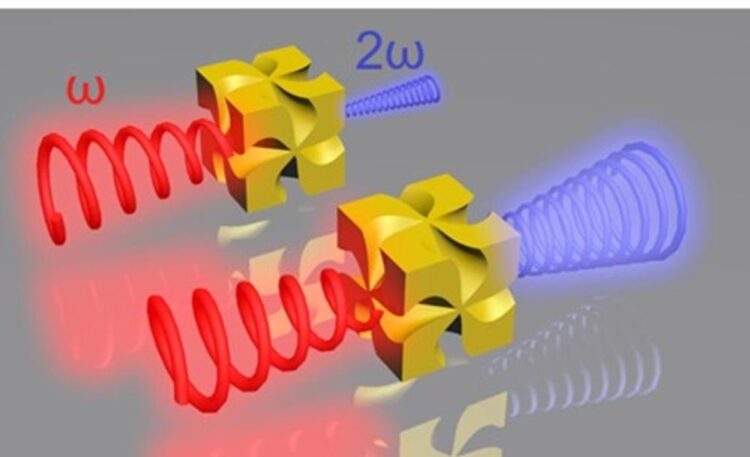Metamaterial significantly enhances the chiral nanoparticle signals

SHG signals of chiral gold nanoparticles that differ significantly for the circular polarizations of the opposite helicity.
Credit: POSTECH
The left hand looks like the right hand in the mirror but the left-handed glove does not fit on the right hand. Chirality refers to this property where the object cannot be superimposed on to the mirror image. This property in molecules is an important factor in pharmaceutical research as it can turn drugs toxic.
These molecules and mirror-symmetrical molecules have the same physical properties, and therefore cannot be distinguished using general optical analysis. Instead, polarized light – that spins in different directions – must be used. In addition, when the molecular size is small compared to the wavelength of light, it has a very weak chiral interaction between light and molecules, rendering it difficult to measure it.
A research team led by Professor Junsuk Rho and Jungho Moon (Department of Mechanical Engineering and Department of Chemical Engineering) at POSTECH in collaboration with Professor Ki Tae Nam and Dr. Hyeohn Kim (Department of Materials Science and Engineering) at Seoul National University and Professor Thomas Zentgraf (Department of Physics) at Paderborn University in Germany have together developed a technology to increase the chirality between light and nanoparticles using the metamaterial1, known as the invisible cloak material.
In general, a signal is generated when light is irradiated on chiral nanoparticles but its intensity is very weak. Therefore, several nanoparticles had to be collected to measure the average signal. To overcome this issue, the research team succeeded in synthesizing an artificial chiral material using metamaterials, significantly strengthening the signal.
The research team measured the chiral linear scattering and second harmonic generation (SHG) scattering of one newly developed chiral nanoparticle. SHG is a phenomenon in which light with twice the frequency (2ω) of the incident light (ω, omega) is generated. Most chiral nanoparticles emit a weak SHG signal, rending it difficult to measure it.
The SHG signal of the chiral nanoparticles developed by the research team was measured to be up to 10 times larger than the linear case. This enables to measure the mirror symmetry of a single nanoparticle with high precision as well as a very small amount of chiral material, and is anticipated to contribute to the accurate structural analysis of chiral nanoparticles in the future.’
The joint research team led by Professor Junsuk Rho of POSTECH and Professor Ki Tae Nam of Seoul National University has been leading the field with continuous joint research after publishing a study on chiral metamaterial synthesis and optical properties as a cover paper in Nature in 2018.
Published in ACS Photonics, this study was led by the Korea-Germany DAAD GenKO Partnership Cooperation program of the National Research Foundation of Korea. The study received additional support from the Creative Discovery Program, Mid-career Researcher Program, Global Frontier Program, the Regional Leading Research Center program of the Ministry of Science and ICT, and support from the Ministry of Education, POSTECH Piuri Fellowship, and LG Display.
Journal: ACS Photonics
DOI: 10.1021/acsphotonics.1c00882
Article Title: Second Harmonic Optical Circular Dichroism of Plasmonic Chiral Helicoid-III Nanoparticles
Article Publication Date: 16-Mar-2022
Media Contact
Jinyoung Huh
Pohang University of Science & Technology (POSTECH)
jyhuh@postech.ac.kr
Office: 82-54-279-2415
All latest news from the category: Materials Sciences
Materials management deals with the research, development, manufacturing and processing of raw and industrial materials. Key aspects here are biological and medical issues, which play an increasingly important role in this field.
innovations-report offers in-depth articles related to the development and application of materials and the structure and properties of new materials.
Newest articles

High-energy-density aqueous battery based on halogen multi-electron transfer
Traditional non-aqueous lithium-ion batteries have a high energy density, but their safety is compromised due to the flammable organic electrolytes they utilize. Aqueous batteries use water as the solvent for…

First-ever combined heart pump and pig kidney transplant
…gives new hope to patient with terminal illness. Surgeons at NYU Langone Health performed the first-ever combined mechanical heart pump and gene-edited pig kidney transplant surgery in a 54-year-old woman…

Biophysics: Testing how well biomarkers work
LMU researchers have developed a method to determine how reliably target proteins can be labeled using super-resolution fluorescence microscopy. Modern microscopy techniques make it possible to examine the inner workings…





















